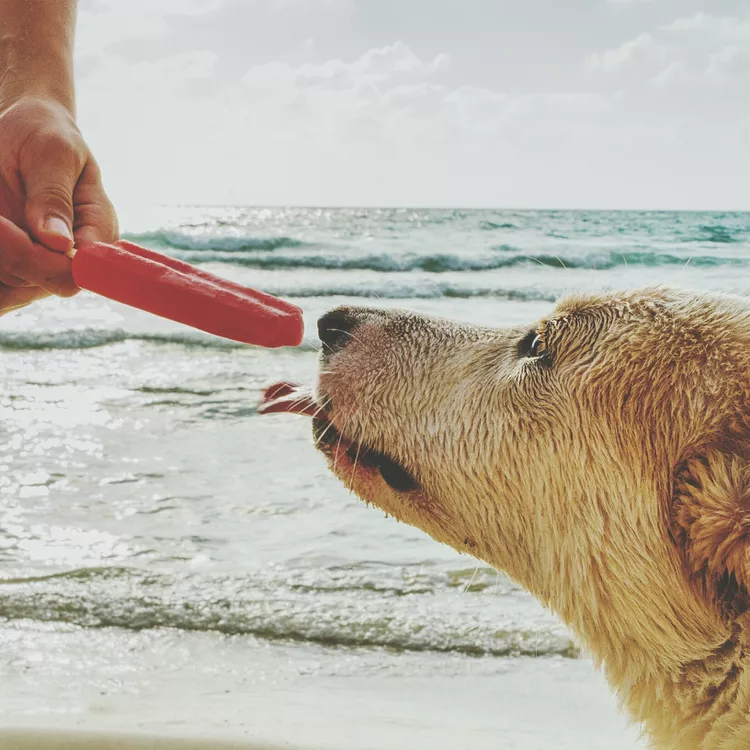Can Dogs Eat Popsicles?

We have all heard the common phrase the dog days of summer, and, sometimes, to beat the heat, popsicles are a great option to keep cool. But is it ok to share with your canine friends?
Is it Safe to Give your Dog Popsicles?
The short answer is yes, but not all popsicles and frozen treats are ok for your dogs. When feeding your dog any food, it is important to be aware of all the ingredients and your dog’s intolerances and allergies. As with any new food, it is always wise to introduce it to your dog slowly, so you can easily determine if your dog has an untoward reaction or any trouble digesting the food.
Instead of sharing your popsicle with your canine friend, it is recommended to make nutritious and healthy popsicles for your dog’s using fruits that are good for them such as apples or bananas.
As with everything, moderation is key. Too many treats, on top of a healthy diet, can lead to canine obesity and this can wreak havoc on your dog's body, especially if your dog is prone to joint issues like hip dysplasia.
Potential Popsicle Health Concerns
Many manufactured popsicles include frozen dairy items such as ice-cream or frozen yogurt. Although, in some cases, these can be offered in small portions, they can also cause gastrointestinal upset including gas, diarrhea, bloating, abdominal discomfort, and vomiting. Many dogs are lactose intolerant meaning that they have difficulty digesting milk and other dairy products.
Popsicles designed for humans can also include toxic substances such as the artificial sweetener xylitol, macadamia nuts, and raisins. Xylitol and raisins are toxic to dogs even in small amounts, so they should be always avoided.
Additionally, some popsicles contain chocolate, and the theobromine in this can lead to toxicity in dogs. If the chocolate in the popsicle or ice cream is dark with a high cocoa content, only a small amount needs to be ingested to cause problems. Dogs may experience gastrointestinal, central nervous, and cardiac troubles
Even if the sugar, artificial flavors, or sweeteners that are common in popsicles are not toxic, they can contribute to obesity and can be a particular problem for dogs with diabetes.
Benefits of Dog-Friendly Popsicles For Your Pooch
Healthy frozen treats can be helpful to keep your dog cool on hot days, as a special treat to reward your dog, and for enrichment.
Providing your dog with enrichment is a crucial part of their care. It helps to prevent boredom and obesity, decreases anxiety and stress, gives the dog some control of their environment, and can help to prevent behavior problems.
Food puzzles are a great option to provide your dogs with enrichment and with many of them, they can be frozen to increase the challenge and provide a long-lasting dog treat.
Healthy Frozen Treat Ideas For Your Dog
Below are some safe and healthy options for healthy frozen treats and homemade popsicles.
Frozen Kongs, Toppl Toys or Similar
A Classic Kong and the West Paw Toppl are both great dog toys that, when filled appropriately, can occupy just about any dog. They are both non-toxic, dishwasher-safe, rubbery toys with a hollow center. There are many other food puzzles options on the market you can try as well. When stuffed with food, they provide a healthy outlet for your dog to chew and lick.
After filling, you can freeze to make them more challenging for your dog and to provide a cool treat. There are various safe and healthy fillings you can stuff into these toys for your dog to enjoy. A few ideas include:
- Mashed Banana
- Canned pumpkin (no more than about a tablespoon per serving as more can cause diarrhea)
- Canned dog food and kibble
- Peanut butter (make sure it doesn't contain xylitol)
- Peas, carrots, and/or diced apple
- Yogurt (plain)
- Dog treats
Mix the desired ingredients together, fill the treat toy, seal the top with peanut butter, squeeze cheese, or Kong paste and then freeze for at least two hours or, ideally, overnight before serving.
An awesome bonus to freezing them is you can keep some in the freezer for whenever you need them. An example might be when you are having work done in your home, you can give your dog a frozen Kong in their safe place prior to the person entering. This can help minimize stress and keep them occupied.
Frozen Dog-Safe Vegetables and Fruit
Frozen green beans, banana chunks, strawberries, blueberries, and peach chunks are just a few examples of safe fruits and veggies that can be frozen and given as a quick treat for your dog. If you’re purchasing packaged frozen items from the grocery store, be sure to read the labels to ensure there is no added xylitol. They can also be blended into a smoothie that can be frozen and made into homemade popsicles.
There are lots of other options for making cool frozen treats for your dogs too. Just make sure whatever you introduce is healthy and appropriate for dogs, fed in moderation, and introduced gradually. Alterations to your dog's usual diet should make up no more than 10% of their daily calorie allowance to prevent issues with nutritional imbalance.